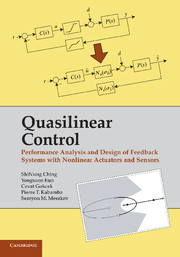 Quasilinear Control
Quasilinear Control Book contents
- Frontmatter
- Contents
- Preface
- 1 Introduction
- 2 Stochastic Linearization of LPNI Systems
- 3 Analysis of Reference Tracking in LPNI Systems
- 4 Analysis of Disturbance Rejection in LPNI Systems
- 5 Design of Reference Tracking Controllers for LPNI Systems
- 6 Design of Disturbance Rejection Controllers for LPNI Systems
- 7 Performance Recovery in LPNI Systems
- 8 Proofs
- Epilogue
- Abbreviations and Notations
- Index
- References
1 - Introduction
Published online by Cambridge University Press: 01 June 2011
- Frontmatter
- Contents
- Preface
- 1 Introduction
- 2 Stochastic Linearization of LPNI Systems
- 3 Analysis of Reference Tracking in LPNI Systems
- 4 Analysis of Disturbance Rejection in LPNI Systems
- 5 Design of Reference Tracking Controllers for LPNI Systems
- 6 Design of Disturbance Rejection Controllers for LPNI Systems
- 7 Performance Recovery in LPNI Systems
- 8 Proofs
- Epilogue
- Abbreviations and Notations
- Index
- References
Summary
Motivation: This chapter is intended to introduce the class of systems addressed in this volume – the so-called Linear Plant/Nonlinear Instrumentation (LPNI) systems – and to characterize the control methodology developed in this book – Quasilinear Control (QLC).
Overview: After introducing the notions of LPNI systems and QLC and listing the problems addressed, the main technique of this book – the method of stochastic linearization – is briefly described and compared with the usual, Jacobian, linearization. In the framework of this comparison, it is shown that the former provides a more accurate description of LPNI systems than the latter, and the controllers designed using the QLC result, generically, yield better performance than those designed using linear control (LC). Finally, the content of the book is outlined.
Linear Plant/Nonlinear Instrumentation Systems and Quasilinear Control
Every control system contains nonlinear instrumentation – actuators and sensors. Indeed, the actuators are ubiquitously saturating; the sensors are often quantized; deadzone, friction, hysteresis, and so on are also encountered in actuator and sensor behavior.
Typically, the plants in control systems are nonlinear as well. However, if a control system operates effectively, that is, maintains its operation in a desired regime, the plant may be linearized and viewed as locally linear. The instrumentation, however, can not: to reject large disturbances, to respond to initial conditions sufficiently far away from the operating point, or to track large changes in reference signals – all may activate essential nonlinearities in actuators and sensors, resulting in fundamentally nonlinear behavior.
- Type
- Chapter
- Information
- Quasilinear ControlPerformance Analysis and Design of Feedback Systems with Nonlinear Sensors and Actuators, pp. 1 - 19Publisher: Cambridge University PressPrint publication year: 2010


